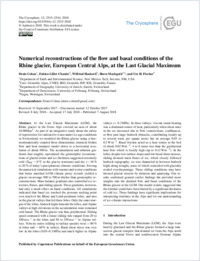Numerical reconstructions of the flow and basal conditions of the Rhine glacier, European Central Alps, at the Last Glacial Maximum
- Cohen, Denis Department of Earth and Environmental Science, New Mexico Tech, Socorro, NM, USA
- Gillet-Chaulet, Fabien Univ. Grenoble Alpes, CNRS, IRD, Grenoble INP, IGE, Grenoble, France
- Haeberli, Wilfried Department of Geography, University of Zurich, Switzerland
- Machguth, Horst Department of Geography, University of Zurich, Switzerland - Department of Geosciences, University of Fribourg, Switzerland
- Fischer, Urs H. Nagra, Wettingen, Switzerland
-
07.08.2018
Published in:
- The Cryosphere. - 2018, vol. 12, no. 8, p. 2515–2544
English
At the Last Glacial Maximum (LGM), the Rhine glacier in the Swiss Alps covered an area of about 16000km2. As part of an integrative study about the safety of repositories for radioactive waste under ice age conditions in Switzerland, we modeled the Rhine glacier using a thermodynamically coupled three-dimensional, transient Stokes flow and heat transport model down to a horizontal resolution of about 500m. The accumulation and ablation gradients that roughly reproduced the geomorphic reconstructions of glacial extent and ice thickness suggested extremely cold (TJuly ∼ 0 °C at the glacier terminus) and dry ( ∼ 10% to 20% of today's precipitation) climatic conditions. Forcing the numerical simulations with warmer and wetter conditions that better matched LGM climate proxy records yielded a glacier on average 500 to 700m thicker than geomorphic reconstructions. Mass balance gradients also controlled ice velocities, fluxes, and sliding speeds. These gradients, however, had only a small effect on basal conditions. All simulations indicated that basal ice reached the pressure melting point over much of the Rhine and Linth piedmont lobes, and also in the glacial valleys that fed these lobes. Only the outer margin of the lobes, bedrock highs beneath the lobes, and Alpine valleys at high elevations in the accumulation zone remained cold based. The Rhine glacier was thus polythermal. Sliding speed estimated with a linear sliding rule ranged from 20 to 100m a−1 in the lobes and 50 to 250m a−1 in Alpine valleys. Velocity ratios (sliding to surface speeds) were > 80% in lobes and ∼ 60% in valleys. Basal shear stress was very low in the lobes (0.03–0.1MPa) and much higher in Alpine valleys ( > 0.2MPa). In these valleys, viscous strain heating was a dominant source of heat, particularly when shear rates in the ice increased due to flow constrictions, confluences, or flow past large bedrock obstacles, contributing locally up to several watts per square meter but on average 0.03 to 0.2W m−2. Basal friction acted as a heat source at the bed of about 0.02W m−2, 4 to 6 times less than the geothermal heat flow which is locally high (up to 0.12W m−2). In the lobes, despite low surface slopes and low basal shear stresses, sliding dictated main fluxes of ice, which closely followed bedrock topography: ice was channeled in between bedrock highs along troughs, some of which coincided with glacially eroded overdeepenings. These sliding conditions may have favored glacial erosion by abrasion and quarrying. Our results confirmed general earlier findings but provided more insights into the detailed flow and basal conditions of the Rhine glacier at the LGM. Our model results suggested that the trimline could have been buried by a significant thickness of cold ice. These findings have significant implications for interpreting trimlines in the Alps and for our understanding of ice– climate interactions.
- Faculty
- Faculté des sciences et de médecine
- Department
- Département de Géosciences
- Language
-
- English
- Classification
- Hydrology
- License
- License undefined
- Identifiers
-
- RERO DOC 323366
- DOI 10.5194/tc-12-2515-2018
- Persistent URL
- https://folia.unifr.ch/unifr/documents/307386
Statistics
Document views: 81
File downloads:
- mac_nrf.pdf: 137
